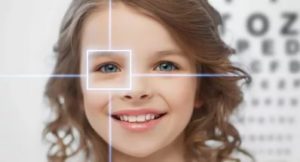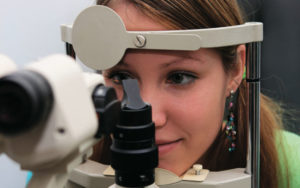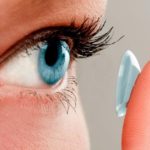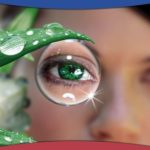How long can you wear contact lenses?
 Everyone wants to see well; the problem of poor vision has always bothered people. Previously, it cost a person a lot and he could not fulfill his duties, therefore he was useless to society. Fortunately, those days are over.
Everyone wants to see well; the problem of poor vision has always bothered people. Previously, it cost a person a lot and he could not fulfill his duties, therefore he was useless to society. Fortunately, those days are over.
We live in a modern, developed world where poor eyesight is no longer perceived as a defect. Although the number of people who have poor vision is regularly growing, vision correction is now available to everyone, even children. This is what we will talk about.
The content of the article
How long can you wear contact lenses?
 Unfortunately, there is no single answer to this question. Some people feel discomfort after 3–5 years. In this case, people are forced to take a break or switch to glasses, or contact ophthalmologists for surgical intervention.
Unfortunately, there is no single answer to this question. Some people feel discomfort after 3–5 years. In this case, people are forced to take a break or switch to glasses, or contact ophthalmologists for surgical intervention.
And some, after 10 years of active wearing, do not experience any discomfort. Everything is individual. The development of science and medicine does not stand still.
From what age can you wear (from what age?)
There are no age restrictions for soft ones with a corrective therapeutic effect. But still, minimal Recommended age: at least 7 years. This is due to the fact that at this age children become more responsible.
Important! Children under 7 years of age may not follow the care rules.Therefore, they may be lost or swallowed. The responsibility for wearing lenses for young children lies with their parents. They themselves must take them off for the child before bed every day, clean and store properly.
How long can you wear daily contact lenses?
 They are put on immediately after sleep, worn all day and taken off in the evening. After this they are thrown away. In the following days, they do the same with the new pair. The greatest value of these lenses is that they are completely sterile. The possibility of eye infection is reduced to a minimum. They do not need to be looked after and have little contact with the environment.
They are put on immediately after sleep, worn all day and taken off in the evening. After this they are thrown away. In the following days, they do the same with the new pair. The greatest value of these lenses is that they are completely sterile. The possibility of eye infection is reduced to a minimum. They do not need to be looked after and have little contact with the environment.
Among the disadvantages are: high price compared to conventional ones; short wearing period, which is why they run out quickly. Important! Do not wear one-day products for more than 2 days. This dramatically increases the risk of developing serious diseases. Due to an increase in lens density and a decrease in incoming air, vision loss is possible.
Can children wear it?
Experts say that age does not play any role in wearing lenses. Moreover, for children they have a number of advantages over glasses: Increases self-esteem and confidence. Teenagers often suffer from ridicule from their peers. Especially if they are myopic and wear glasses. This develops complexes in children, self-hatred and can damage the psyche.
Eighty percent of parents confirm that wearing lenses has improved their children's quality of life and self-esteem. Children are very active. Glasses, no matter how expensive, interfere with most sports. You can run, jump, dance and even swim. Losing them is much cheaper than buying new glasses. In addition, they greatly enhance the field of view, which glasses cannot do.
Which ones are suitable for children?
Soft daytime, nighttime and RGP (hard gas permeable) lenses are made for children. One-day ones are most suitable for wearing by children. They do not need to be further disinfected or cleaned. They are easy to use. And when wearing lenses intended for 1-2 weeks or a month, the risk of infection increases due to improper care. The products are not prescribed to children for a longer period.
Reusable
Lenses with a wear period of 1 week to 3 months are suitable only for responsible children. For those who are ready to carry out all care procedures every day. Lenses intended for a longer period (3 or more months) are not prescribed to children. Due to the fact that over time deposits and infections appear on them, they become unsuitable for use.
Night
They are good for temporary restoration. They are put on before going to bed for the whole night. By correcting the cornea, they improve vision for the entire next day. The advantage of this method is that parents have complete control over the process of vision correction. The risk of losing a lens and the possibility of getting an infection without following hygiene rules is minimized.
Hard
They are prescribed to children in extreme cases, when the usual ones do not give the desired result. For example, a high degree of astigmatism. Due to the fact that they are made of hard material and are small in size, you need to get used to them. But such lenses are more durable. With proper care, they can be worn for several years. In addition, they have high quality vision correction.
Important! Do not choose products yourself, otherwise you will only complicate your vision problems. Only an ophthalmologist will select the type that is suitable in size and properties.
 Special equipment is used for this. But the final choice will be made only after trying on.
Special equipment is used for this. But the final choice will be made only after trying on.
Security measures
Failure to comply with precautions will have serious consequences. For example, a corneal ulcer may develop. In the worst case scenario, loss of vision. Care rules are the same for children and adults:
- Before handling lenses, always wash your hands and dry with a clean, lint-free towel. For washing, disinfection and storage, use only a special liquid.
- store and wear for no more than the specified period. Do not wear them if your eyes are red. If symptoms such as discomfort, pain, burning, itching appear, remove them immediately.
- Consult a doctor to eliminate the possibility of infection. At night, wear only those lenses that are intended for this purpose. Otherwise, it may increase the risk of developing a corneal ulcer.
Contraindications for wearing lenses for children
Unfortunately, lenses will not always help improve a child’s vision. They are prohibited from wearing for certain diseases. The main ones include:
- infectious eye diseases (conjunctivitis, blepharitis);
- allergies and eye sensitivity;
- strabismus (if the angle of curvature is more than 15°);
- problems with tear production; glaucoma;
- tuberculosis;
- Pain in the eyes,
- redness,
- itching,
- swelling of the eyelids;
- respiratory problems;
- colds.
Myths and facts
 Proponents of contact lenses actively talk about their positive effects on vision and the eyes in general. Opponents deny everything with no less enthusiasm. Let's look at some facts and myths about lenses:
Proponents of contact lenses actively talk about their positive effects on vision and the eyes in general. Opponents deny everything with no less enthusiasm. Let's look at some facts and myths about lenses:
- Contact lenses are harmful and uncomfortable. It used to be like this. But modern ones are not even felt before our eyes. However, some people wear them for more than 10 years. They do not complain of blurred vision.
- they are dangerous and can injure your eyes. If you follow the rules, the possibility of damaging your eyes is reduced to zero.
- may stick to the eye. This is not true, it can be removed very easily. It just takes a little practice.
- may fall out. Normal lenses will not fall out, even if you play sports. But still, upon contact with water or drying out (swimming, relaxing in a bathhouse, getting smoke in the eyes), this can happen.
- Children should not wear it. Doctors have proven that there is no difference: an adult or a child. Children's eyes get used to them very well.
In the article we examined important issues that concern many. We realized that lenses are a good way to correct vision. With proper care, they are completely safe even for children. There is no general wearing period. Wear as much as you want, just follow the rules and pay attention to changes in time.





